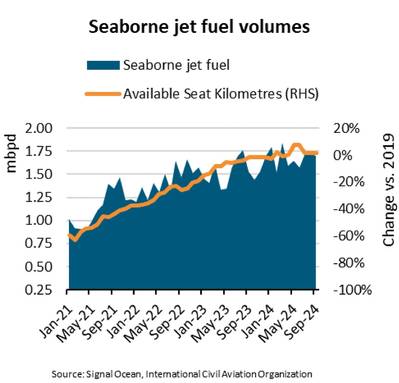Jet Fuel, up 11%, Powers Tanker Market
“During the first nine months of 2024, seaborne shipments of jet fuel increased 11% over 2023," said Niels Rasmussen, Chief Shipping Analyst at BIMCO. "Shipments were equivalent to 461 million barrels or 1.7 million barrels per day (mbpd). At the same time, airline passenger traffic measured in Available Seat Kilometres (ASK) exceeded 2019 levels for the first time since COVID,”
Airline cargo traffic recovered quickly after the COVID pandemic hit in 2020 and has since remained mostly within +/-10% of 2019 levels. However, passenger traffic continued to linger well below the pre-COVID levels in 2019 and in 2023, ASK ended 6.2% below 2019 levels.
“For the first year since COVID, Available Seat Kilometers have stayed consistently above 2019 levels so far this year. Year-to-date, ASK has been 3.1% higher than in 2019,” says Rasmussen.
The recovery in airline traffic has supported jet fuel volumes with year-to-date volumes now 56% higher than in 2021. At the same time, jet fuel has increased from contributing 6.0% of clean petroleum product volumes in 2021 to 8.5% so far this year.
Shipments from the Persian Gulf and the Red Sea have contributed 41% of the increase in volumes between 2021 and 2024, whereas China, South Asia and North America have contributed 24%, 15% and 13% respectively.
From a destination perspective, volumes into North Europe and the Mediterranean have been responsible for most of the increases at 36% and 15% respectively.
Broadly speaking, trading patterns have remained the same during the past four years, although the crisis in the Red Sea has increased average sailing distances significantly. Trade in the West within the Atlantic Ocean makes up nearly 25% of total trade while trade in the East within the Indian and Pacific Oceans makes up about 35%. The remaining 40% is from East to West.
LR2s have in the meantime gained share for the smaller MRs and Handy segments, especially within East to West Trade. Year-to-date, LR2s have therefore loaded 23% of jet fuel compared to 17% in 2021.












